Analysis of Independence Threats and Safeguards in Auditing
VerifiedAdded on 2019/10/31
|7
|1478
|166
Homework Assignment
AI Summary
This assignment provides a comprehensive summary of independence threats and safeguards in financial auditing. It begins by addressing specific scenarios, identifying threats such as self-review, familiarity, and self-interest, and explaining how these threats can compromise auditor independence. The analysis includes practical examples, such as the implications of a former employee joining the audit team or an auditor's close relationship with a client. Furthermore, the assignment discusses the importance of auditor's reports in communicating financial information, highlighting the essential elements that should be included, such as critical audit matters and a standardized format. The document references key academic research to support its analysis, making it a valuable resource for students studying auditing and financial reporting. The assignment emphasizes the need for auditors to maintain objectivity and integrity to ensure the reliability of financial statements for stakeholders.
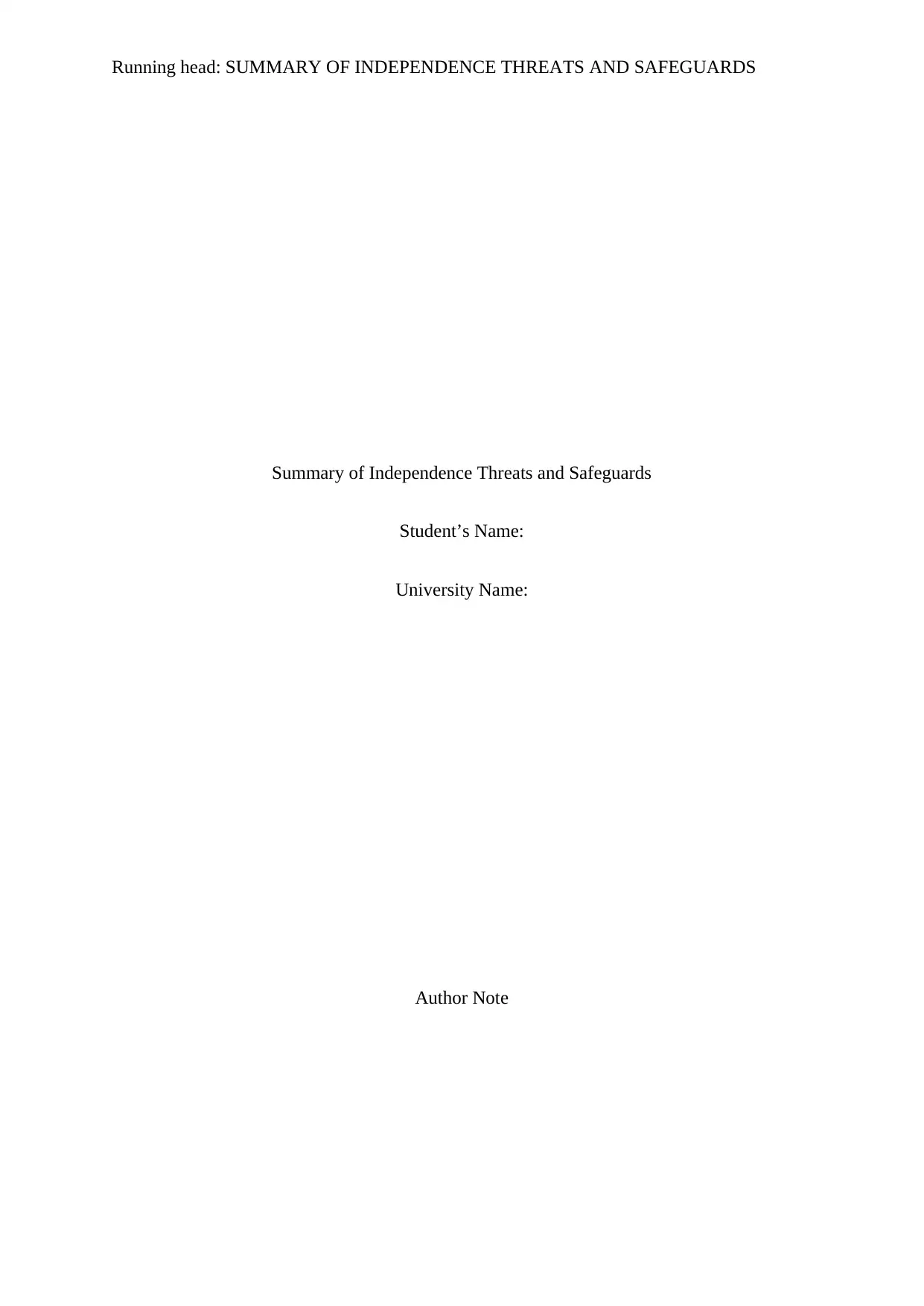
Running head: SUMMARY OF INDEPENDENCE THREATS AND SAFEGUARDS
Summary of Independence Threats and Safeguards
Student’s Name:
University Name:
Author Note
Summary of Independence Threats and Safeguards
Student’s Name:
University Name:
Author Note
Paraphrase This Document
Need a fresh take? Get an instant paraphrase of this document with our AI Paraphraser
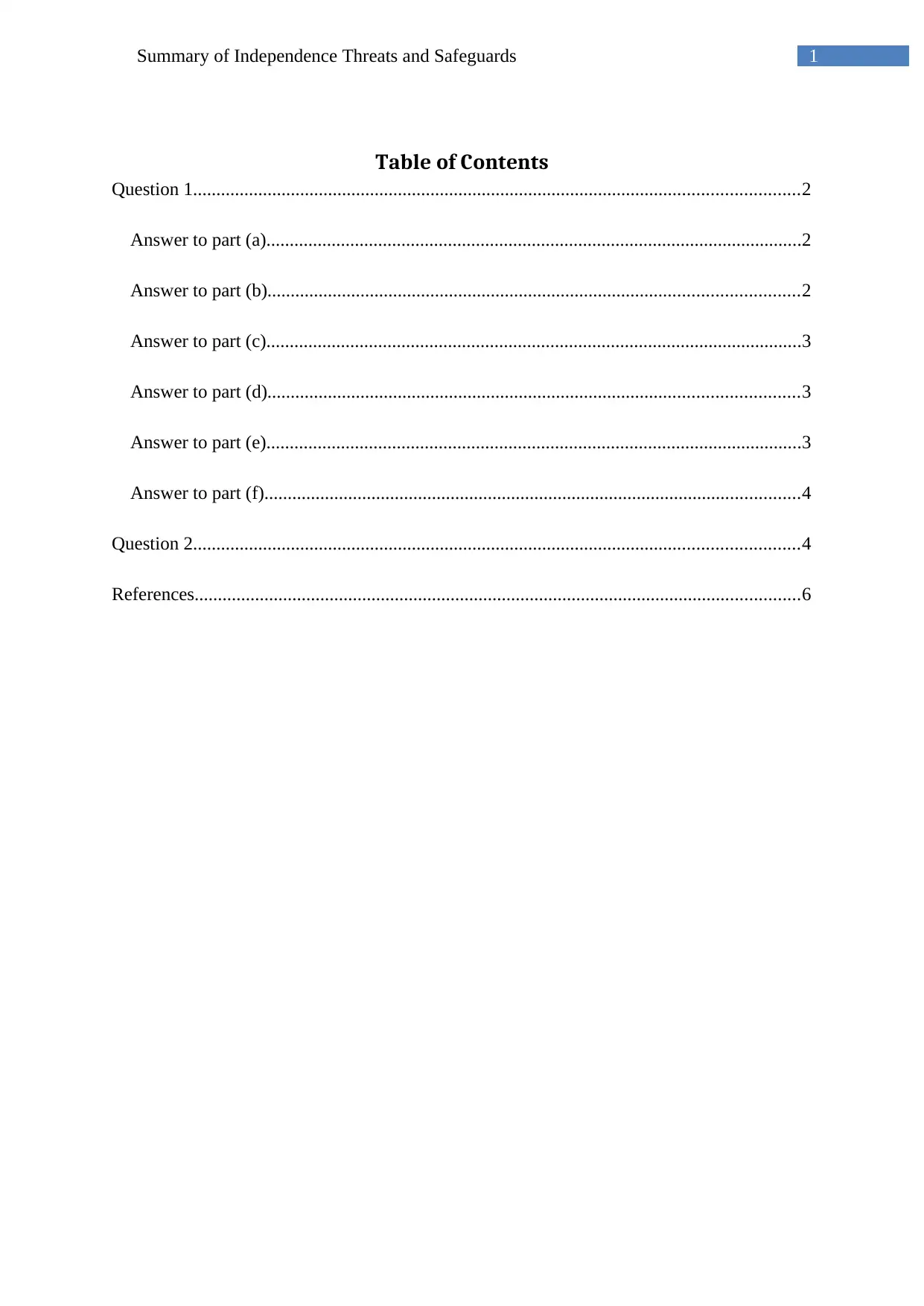
1Summary of Independence Threats and Safeguards
Table of Contents
Question 1..................................................................................................................................2
Answer to part (a)...................................................................................................................2
Answer to part (b)..................................................................................................................2
Answer to part (c)...................................................................................................................3
Answer to part (d)..................................................................................................................3
Answer to part (e)...................................................................................................................3
Answer to part (f)...................................................................................................................4
Question 2..................................................................................................................................4
References..................................................................................................................................6
Table of Contents
Question 1..................................................................................................................................2
Answer to part (a)...................................................................................................................2
Answer to part (b)..................................................................................................................2
Answer to part (c)...................................................................................................................3
Answer to part (d)..................................................................................................................3
Answer to part (e)...................................................................................................................3
Answer to part (f)...................................................................................................................4
Question 2..................................................................................................................................4
References..................................................................................................................................6
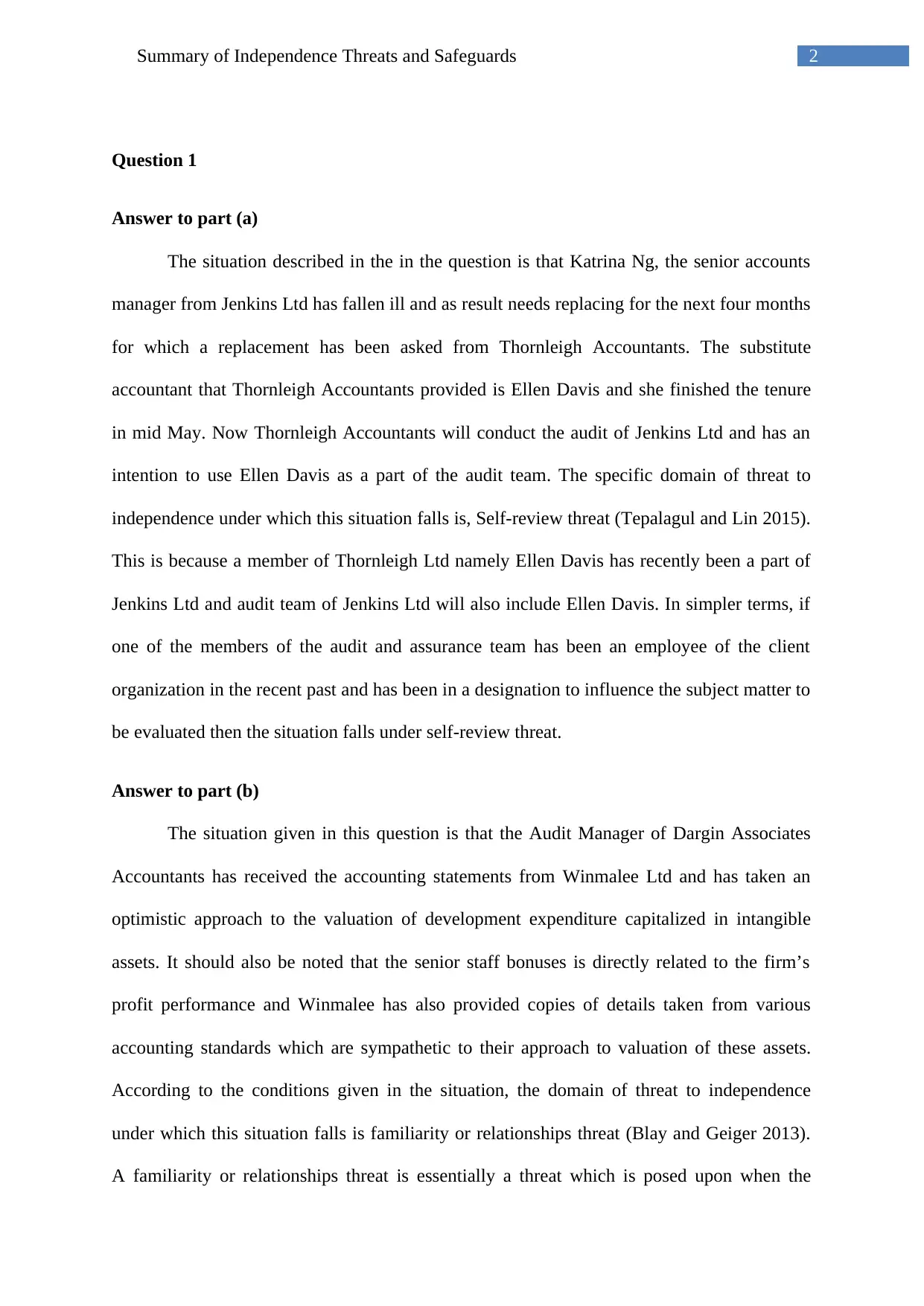
2Summary of Independence Threats and Safeguards
Question 1
Answer to part (a)
The situation described in the in the question is that Katrina Ng, the senior accounts
manager from Jenkins Ltd has fallen ill and as result needs replacing for the next four months
for which a replacement has been asked from Thornleigh Accountants. The substitute
accountant that Thornleigh Accountants provided is Ellen Davis and she finished the tenure
in mid May. Now Thornleigh Accountants will conduct the audit of Jenkins Ltd and has an
intention to use Ellen Davis as a part of the audit team. The specific domain of threat to
independence under which this situation falls is, Self-review threat (Tepalagul and Lin 2015).
This is because a member of Thornleigh Ltd namely Ellen Davis has recently been a part of
Jenkins Ltd and audit team of Jenkins Ltd will also include Ellen Davis. In simpler terms, if
one of the members of the audit and assurance team has been an employee of the client
organization in the recent past and has been in a designation to influence the subject matter to
be evaluated then the situation falls under self-review threat.
Answer to part (b)
The situation given in this question is that the Audit Manager of Dargin Associates
Accountants has received the accounting statements from Winmalee Ltd and has taken an
optimistic approach to the valuation of development expenditure capitalized in intangible
assets. It should also be noted that the senior staff bonuses is directly related to the firm’s
profit performance and Winmalee has also provided copies of details taken from various
accounting standards which are sympathetic to their approach to valuation of these assets.
According to the conditions given in the situation, the domain of threat to independence
under which this situation falls is familiarity or relationships threat (Blay and Geiger 2013).
A familiarity or relationships threat is essentially a threat which is posed upon when the
Question 1
Answer to part (a)
The situation described in the in the question is that Katrina Ng, the senior accounts
manager from Jenkins Ltd has fallen ill and as result needs replacing for the next four months
for which a replacement has been asked from Thornleigh Accountants. The substitute
accountant that Thornleigh Accountants provided is Ellen Davis and she finished the tenure
in mid May. Now Thornleigh Accountants will conduct the audit of Jenkins Ltd and has an
intention to use Ellen Davis as a part of the audit team. The specific domain of threat to
independence under which this situation falls is, Self-review threat (Tepalagul and Lin 2015).
This is because a member of Thornleigh Ltd namely Ellen Davis has recently been a part of
Jenkins Ltd and audit team of Jenkins Ltd will also include Ellen Davis. In simpler terms, if
one of the members of the audit and assurance team has been an employee of the client
organization in the recent past and has been in a designation to influence the subject matter to
be evaluated then the situation falls under self-review threat.
Answer to part (b)
The situation given in this question is that the Audit Manager of Dargin Associates
Accountants has received the accounting statements from Winmalee Ltd and has taken an
optimistic approach to the valuation of development expenditure capitalized in intangible
assets. It should also be noted that the senior staff bonuses is directly related to the firm’s
profit performance and Winmalee has also provided copies of details taken from various
accounting standards which are sympathetic to their approach to valuation of these assets.
According to the conditions given in the situation, the domain of threat to independence
under which this situation falls is familiarity or relationships threat (Blay and Geiger 2013).
A familiarity or relationships threat is essentially a threat which is posed upon when the
⊘ This is a preview!⊘
Do you want full access?
Subscribe today to unlock all pages.

Trusted by 1+ million students worldwide
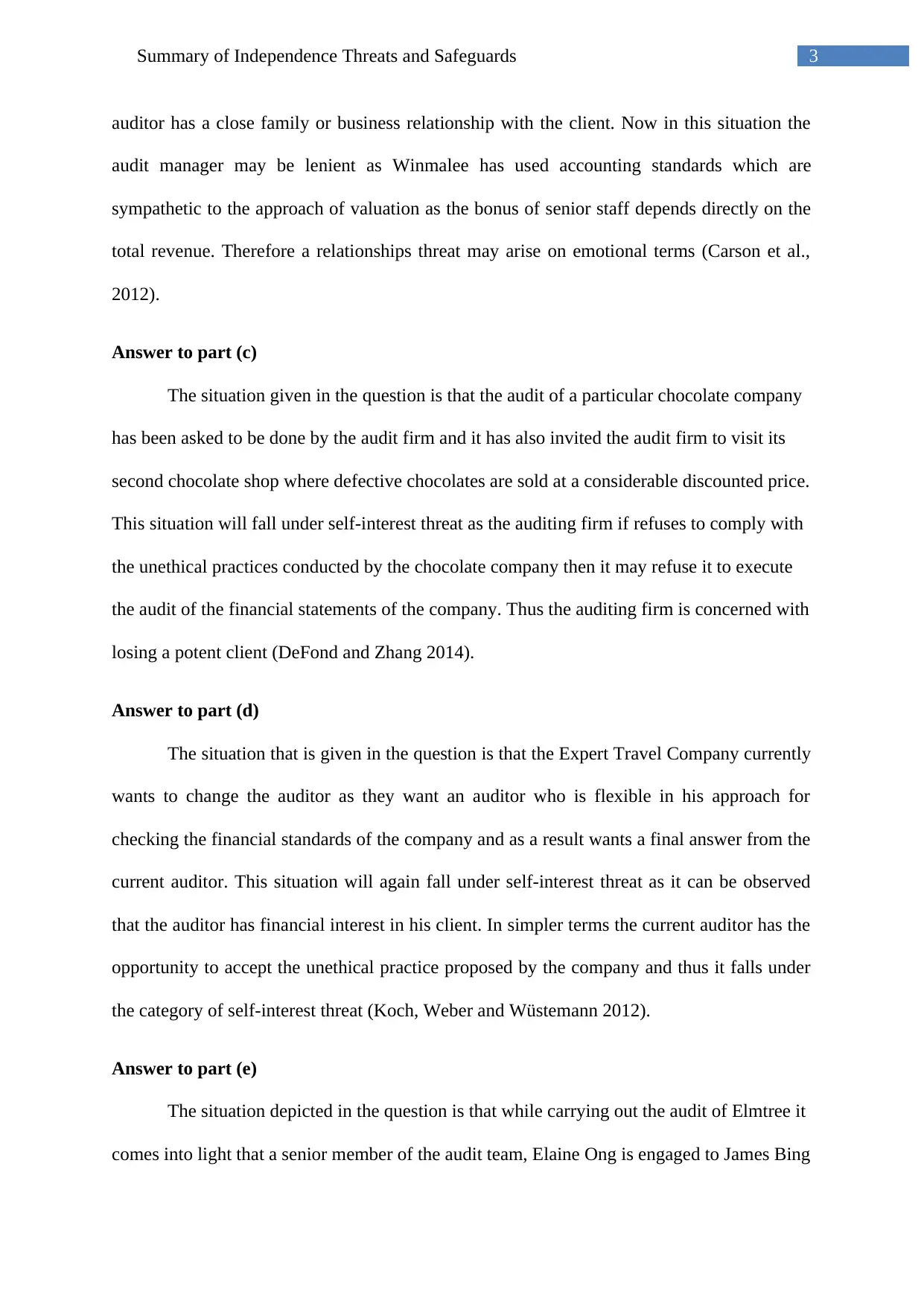
3Summary of Independence Threats and Safeguards
auditor has a close family or business relationship with the client. Now in this situation the
audit manager may be lenient as Winmalee has used accounting standards which are
sympathetic to the approach of valuation as the bonus of senior staff depends directly on the
total revenue. Therefore a relationships threat may arise on emotional terms (Carson et al.,
2012).
Answer to part (c)
The situation given in the question is that the audit of a particular chocolate company
has been asked to be done by the audit firm and it has also invited the audit firm to visit its
second chocolate shop where defective chocolates are sold at a considerable discounted price.
This situation will fall under self-interest threat as the auditing firm if refuses to comply with
the unethical practices conducted by the chocolate company then it may refuse it to execute
the audit of the financial statements of the company. Thus the auditing firm is concerned with
losing a potent client (DeFond and Zhang 2014).
Answer to part (d)
The situation that is given in the question is that the Expert Travel Company currently
wants to change the auditor as they want an auditor who is flexible in his approach for
checking the financial standards of the company and as a result wants a final answer from the
current auditor. This situation will again fall under self-interest threat as it can be observed
that the auditor has financial interest in his client. In simpler terms the current auditor has the
opportunity to accept the unethical practice proposed by the company and thus it falls under
the category of self-interest threat (Koch, Weber and Wüstemann 2012).
Answer to part (e)
The situation depicted in the question is that while carrying out the audit of Elmtree it
comes into light that a senior member of the audit team, Elaine Ong is engaged to James Bing
auditor has a close family or business relationship with the client. Now in this situation the
audit manager may be lenient as Winmalee has used accounting standards which are
sympathetic to the approach of valuation as the bonus of senior staff depends directly on the
total revenue. Therefore a relationships threat may arise on emotional terms (Carson et al.,
2012).
Answer to part (c)
The situation given in the question is that the audit of a particular chocolate company
has been asked to be done by the audit firm and it has also invited the audit firm to visit its
second chocolate shop where defective chocolates are sold at a considerable discounted price.
This situation will fall under self-interest threat as the auditing firm if refuses to comply with
the unethical practices conducted by the chocolate company then it may refuse it to execute
the audit of the financial statements of the company. Thus the auditing firm is concerned with
losing a potent client (DeFond and Zhang 2014).
Answer to part (d)
The situation that is given in the question is that the Expert Travel Company currently
wants to change the auditor as they want an auditor who is flexible in his approach for
checking the financial standards of the company and as a result wants a final answer from the
current auditor. This situation will again fall under self-interest threat as it can be observed
that the auditor has financial interest in his client. In simpler terms the current auditor has the
opportunity to accept the unethical practice proposed by the company and thus it falls under
the category of self-interest threat (Koch, Weber and Wüstemann 2012).
Answer to part (e)
The situation depicted in the question is that while carrying out the audit of Elmtree it
comes into light that a senior member of the audit team, Elaine Ong is engaged to James Bing
Paraphrase This Document
Need a fresh take? Get an instant paraphrase of this document with our AI Paraphraser
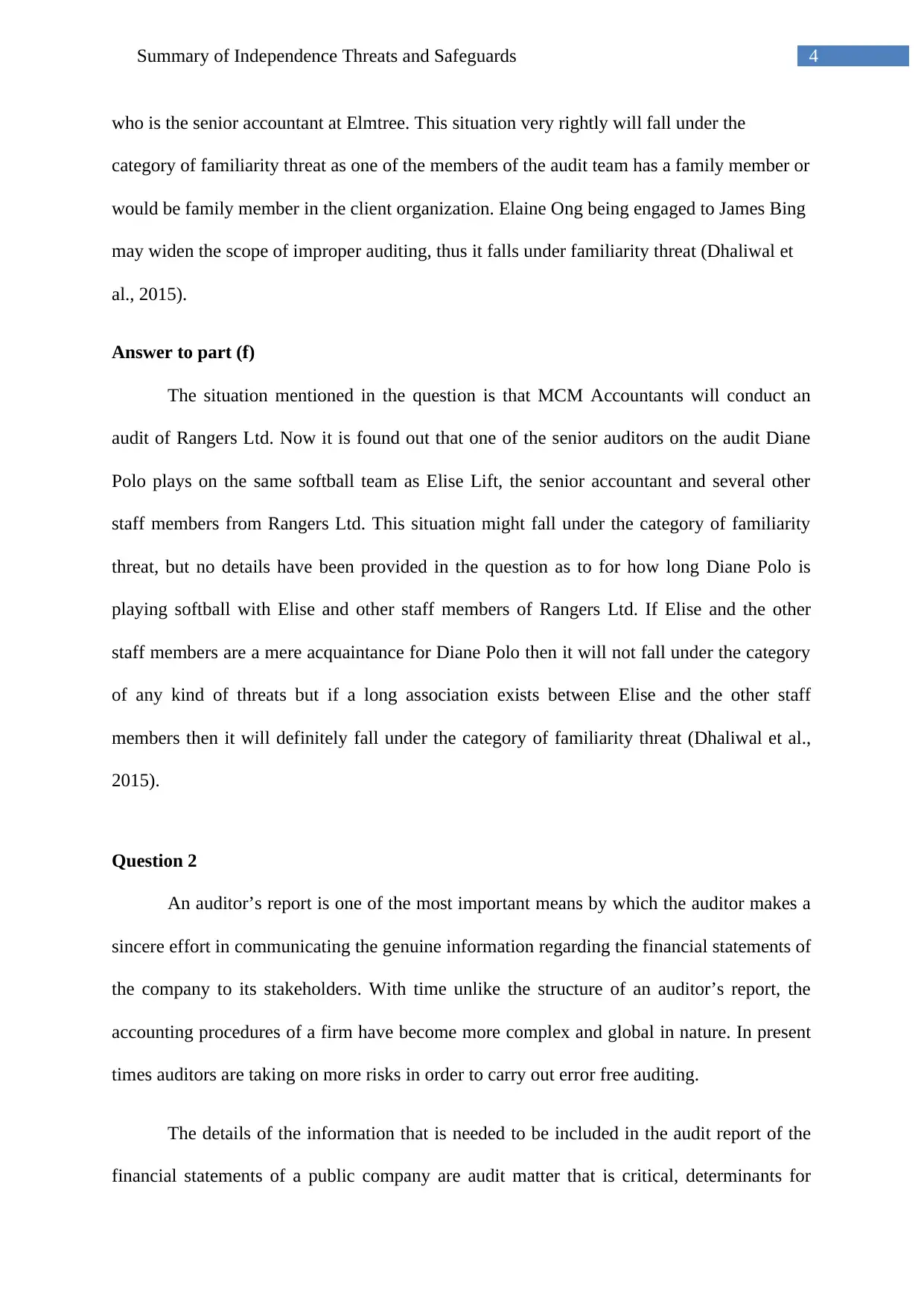
4Summary of Independence Threats and Safeguards
who is the senior accountant at Elmtree. This situation very rightly will fall under the
category of familiarity threat as one of the members of the audit team has a family member or
would be family member in the client organization. Elaine Ong being engaged to James Bing
may widen the scope of improper auditing, thus it falls under familiarity threat (Dhaliwal et
al., 2015).
Answer to part (f)
The situation mentioned in the question is that MCM Accountants will conduct an
audit of Rangers Ltd. Now it is found out that one of the senior auditors on the audit Diane
Polo plays on the same softball team as Elise Lift, the senior accountant and several other
staff members from Rangers Ltd. This situation might fall under the category of familiarity
threat, but no details have been provided in the question as to for how long Diane Polo is
playing softball with Elise and other staff members of Rangers Ltd. If Elise and the other
staff members are a mere acquaintance for Diane Polo then it will not fall under the category
of any kind of threats but if a long association exists between Elise and the other staff
members then it will definitely fall under the category of familiarity threat (Dhaliwal et al.,
2015).
Question 2
An auditor’s report is one of the most important means by which the auditor makes a
sincere effort in communicating the genuine information regarding the financial statements of
the company to its stakeholders. With time unlike the structure of an auditor’s report, the
accounting procedures of a firm have become more complex and global in nature. In present
times auditors are taking on more risks in order to carry out error free auditing.
The details of the information that is needed to be included in the audit report of the
financial statements of a public company are audit matter that is critical, determinants for
who is the senior accountant at Elmtree. This situation very rightly will fall under the
category of familiarity threat as one of the members of the audit team has a family member or
would be family member in the client organization. Elaine Ong being engaged to James Bing
may widen the scope of improper auditing, thus it falls under familiarity threat (Dhaliwal et
al., 2015).
Answer to part (f)
The situation mentioned in the question is that MCM Accountants will conduct an
audit of Rangers Ltd. Now it is found out that one of the senior auditors on the audit Diane
Polo plays on the same softball team as Elise Lift, the senior accountant and several other
staff members from Rangers Ltd. This situation might fall under the category of familiarity
threat, but no details have been provided in the question as to for how long Diane Polo is
playing softball with Elise and other staff members of Rangers Ltd. If Elise and the other
staff members are a mere acquaintance for Diane Polo then it will not fall under the category
of any kind of threats but if a long association exists between Elise and the other staff
members then it will definitely fall under the category of familiarity threat (Dhaliwal et al.,
2015).
Question 2
An auditor’s report is one of the most important means by which the auditor makes a
sincere effort in communicating the genuine information regarding the financial statements of
the company to its stakeholders. With time unlike the structure of an auditor’s report, the
accounting procedures of a firm have become more complex and global in nature. In present
times auditors are taking on more risks in order to carry out error free auditing.
The details of the information that is needed to be included in the audit report of the
financial statements of a public company are audit matter that is critical, determinants for
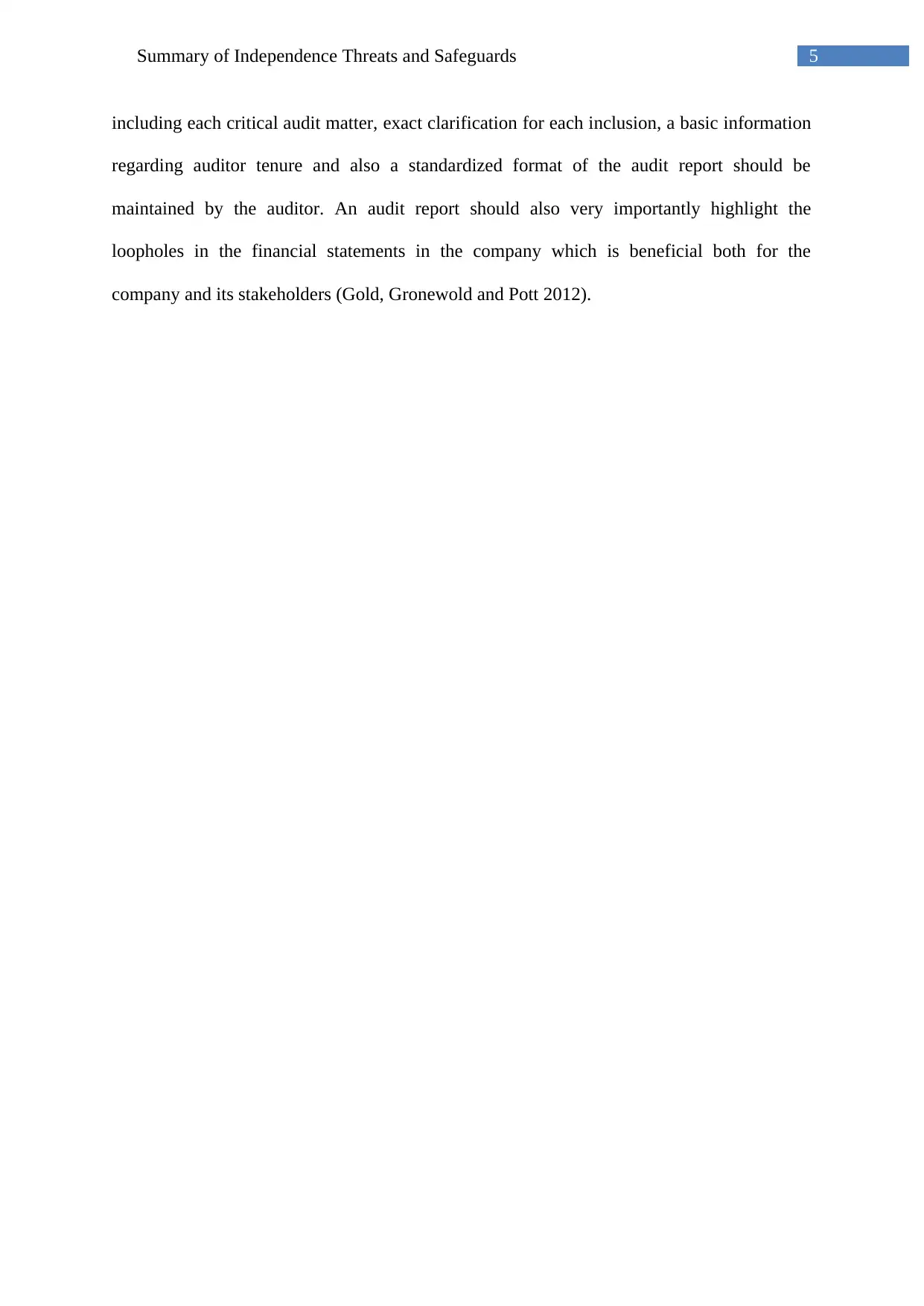
5Summary of Independence Threats and Safeguards
including each critical audit matter, exact clarification for each inclusion, a basic information
regarding auditor tenure and also a standardized format of the audit report should be
maintained by the auditor. An audit report should also very importantly highlight the
loopholes in the financial statements in the company which is beneficial both for the
company and its stakeholders (Gold, Gronewold and Pott 2012).
including each critical audit matter, exact clarification for each inclusion, a basic information
regarding auditor tenure and also a standardized format of the audit report should be
maintained by the auditor. An audit report should also very importantly highlight the
loopholes in the financial statements in the company which is beneficial both for the
company and its stakeholders (Gold, Gronewold and Pott 2012).
⊘ This is a preview!⊘
Do you want full access?
Subscribe today to unlock all pages.

Trusted by 1+ million students worldwide
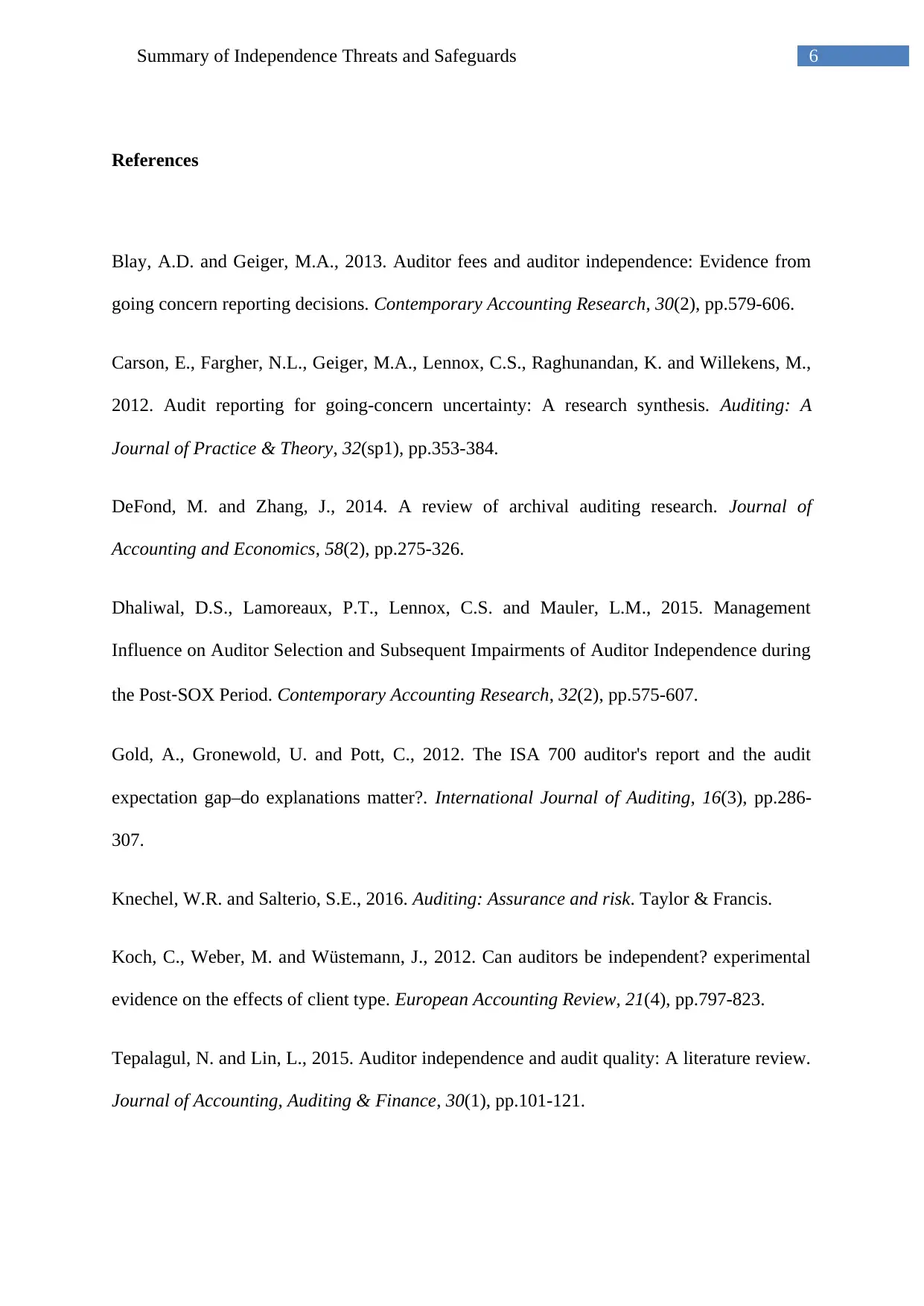
6Summary of Independence Threats and Safeguards
References
Blay, A.D. and Geiger, M.A., 2013. Auditor fees and auditor independence: Evidence from
going concern reporting decisions. Contemporary Accounting Research, 30(2), pp.579-606.
Carson, E., Fargher, N.L., Geiger, M.A., Lennox, C.S., Raghunandan, K. and Willekens, M.,
2012. Audit reporting for going-concern uncertainty: A research synthesis. Auditing: A
Journal of Practice & Theory, 32(sp1), pp.353-384.
DeFond, M. and Zhang, J., 2014. A review of archival auditing research. Journal of
Accounting and Economics, 58(2), pp.275-326.
Dhaliwal, D.S., Lamoreaux, P.T., Lennox, C.S. and Mauler, L.M., 2015. Management
Influence on Auditor Selection and Subsequent Impairments of Auditor Independence during
the Post‐SOX Period. Contemporary Accounting Research, 32(2), pp.575-607.
Gold, A., Gronewold, U. and Pott, C., 2012. The ISA 700 auditor's report and the audit
expectation gap–do explanations matter?. International Journal of Auditing, 16(3), pp.286-
307.
Knechel, W.R. and Salterio, S.E., 2016. Auditing: Assurance and risk. Taylor & Francis.
Koch, C., Weber, M. and Wüstemann, J., 2012. Can auditors be independent? experimental
evidence on the effects of client type. European Accounting Review, 21(4), pp.797-823.
Tepalagul, N. and Lin, L., 2015. Auditor independence and audit quality: A literature review.
Journal of Accounting, Auditing & Finance, 30(1), pp.101-121.
References
Blay, A.D. and Geiger, M.A., 2013. Auditor fees and auditor independence: Evidence from
going concern reporting decisions. Contemporary Accounting Research, 30(2), pp.579-606.
Carson, E., Fargher, N.L., Geiger, M.A., Lennox, C.S., Raghunandan, K. and Willekens, M.,
2012. Audit reporting for going-concern uncertainty: A research synthesis. Auditing: A
Journal of Practice & Theory, 32(sp1), pp.353-384.
DeFond, M. and Zhang, J., 2014. A review of archival auditing research. Journal of
Accounting and Economics, 58(2), pp.275-326.
Dhaliwal, D.S., Lamoreaux, P.T., Lennox, C.S. and Mauler, L.M., 2015. Management
Influence on Auditor Selection and Subsequent Impairments of Auditor Independence during
the Post‐SOX Period. Contemporary Accounting Research, 32(2), pp.575-607.
Gold, A., Gronewold, U. and Pott, C., 2012. The ISA 700 auditor's report and the audit
expectation gap–do explanations matter?. International Journal of Auditing, 16(3), pp.286-
307.
Knechel, W.R. and Salterio, S.E., 2016. Auditing: Assurance and risk. Taylor & Francis.
Koch, C., Weber, M. and Wüstemann, J., 2012. Can auditors be independent? experimental
evidence on the effects of client type. European Accounting Review, 21(4), pp.797-823.
Tepalagul, N. and Lin, L., 2015. Auditor independence and audit quality: A literature review.
Journal of Accounting, Auditing & Finance, 30(1), pp.101-121.
1 out of 7
Related Documents
Your All-in-One AI-Powered Toolkit for Academic Success.
+13062052269
info@desklib.com
Available 24*7 on WhatsApp / Email
![[object Object]](/_next/static/media/star-bottom.7253800d.svg)
Unlock your academic potential
Copyright © 2020–2025 A2Z Services. All Rights Reserved. Developed and managed by ZUCOL.





